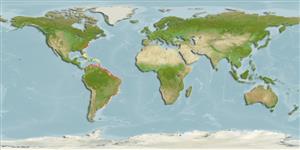Environment: milieu / climate zone / depth range / distribution range
Ecology
Marine; pelagic-neritic; depth range 0 - 100 m (Ref. 106604). Tropical; 41°N - 40°S, 80°W - 29°W
Western Atlantic: New Jersey, USA (Ref. 7251) to Santos, Brazil (Ref. 26340) and Argentina (Ref. 58839). Eastern Atlantic: St. Paul's Rocks (Ref. 13121).
Size / Weight / Age
Maturity: Lm ? range ? - ? cm
Max length : 230 cm WD male/unsexed; (Ref. 126011); max. published weight: 115.9 kg (Ref. 126011)
Cephalic fins smaller, tail longer without spine (Ref. 7251). Upper surface black (Ref. 6902).
Occurs in shallow coastal waters (Ref. 12951). Feeds mainly on planktonic crustaceans but may take small schooling fishes (Ref. 12951). Ovoviviparous (Ref. 50449). Found singly, in small groups, and in schools (Ref. 12951). Swimming at high speed and often leap high above the surface (Ref. 6902). Feeds mainly on planktonic crustaceans, but also on small schooling fishes (Ref. 114953). Meat used for food and a source of oil (Ref. 6902).
Life cycle and mating behavior
Maturity | Reproduction | Spawning | Eggs | Fecundity | Larvae
Exhibit ovoviparity (aplacental viviparity), with embryos feeding initially on yolk, then receiving additional nourishment from the mother by indirect absorption of uterine fluid enriched with mucus, fat or protein through specialised structures (Ref. 50449). Copulation has been observed to be in a venter to venter position while the pair swims at the surface. Mating reported to last 10 minutes. Litter number 1 (Ref. 12951).
Robins, C.R. and G.C. Ray, 1986. A field guide to Atlantic coast fishes of North America. Houghton Mifflin Company, Boston, U.S.A. 354 p. (Ref. 7251)
IUCN Red List Status (Ref. 130435: Version 2024-1)
Threat to humans
Harmless
Human uses
Fisheries: minor commercial
Tools
Special reports
Download XML
Internet sources
Estimates based on models
Preferred temperature (Ref.
123201): 13.7 - 27.7, mean 23.2 °C (based on 232 cells).
Phylogenetic diversity index (Ref.
82804): PD
50 = 0.5005 [Uniqueness, from 0.5 = low to 2.0 = high].
Bayesian length-weight: a=0.01000 (0.00244 - 0.04107), b=3.04 (2.81 - 3.27), in cm total length, based on all LWR estimates for this body shape (Ref.
93245).
Trophic level (Ref.
69278): 3.8 ±0.59 se; based on food items.
Resilience (Ref.
120179): Very Low, minimum population doubling time more than 14 years (Fec=1).
Fishing Vulnerability (Ref.
59153): Very high vulnerability (85 of 100).
